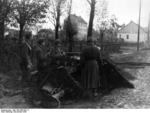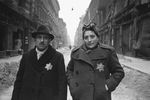Budapest Strategic Offensive Operation
Contributor: C. Peter Chen
ww2dbaseIn late Sep 1944, after the conquest of Romania and Yugoslavia had been secured, Soviet troops began to march across the southern border of Hungary. Secretly, some Hungarian leaders began dispatching envoys to the Soviet Union to negotiate an armistice, but the negotiations would take time to complete. Meanwhile, German and Hungarian forces made a push against the Soviets, striking in the area of Debrecen, Hungary's second largest city, inflicting 25,000 Soviet casualties and destroying 600 tanks. In response, the Soviet 2nd Ukrainian Front, 3rd Ukrainian Front, and 4th Ukrainian Front commenced the Budapest Strategic Offensive Operation on 30 Oct 1944, pushing the Axis lines of defense back into the southern suburbs of Budapest by 2 Nov. On 9 Dec, Soviet troops reached the Danube River north of Budapest, and by 26 Dec Budapest had been surrounded. On 31 Dec 1944, the Hungarian Provisional Government announced that Hungary would switch sides, declaring war on Germany. On 18 Jan 1945, the Germans attempted an attack from the outside to break the siege, but it would fail; on 10 Feb, the remaining 16,000 German troops made an attempt to break out from the inside, and it would fail and would be met with extremely high casualties. Soviet troops claimed victory at Budapest on 13 Feb, thus ending the Budapest Strategic Offensive Operation (although the Soviets would not complete the conquest of all of Hungary until early Apr 1945).
ww2dbaseSoviet Marshal Rodion Malinovsky permitted, as did other top level Soviet generals, gave his victorious troops the permission to plunder as a reward to their hard fighting. What ensued was weeks of looting, rape, and murder. Swiss diplomats stationed in Budapest, after returning to their home country, reported in May 1945 that women ages ranging from 10 to 70 were brutally raped, while virtually anything of value that could be carried away were looted, and everything that could not be carried away such as furniture and pieces of art were smashed or burned. Even embassies of neutral countries did not escape harm; the Swiss embassy, for example, saw one of its officials nearly strangled to death as the safe he was guarding, containing millions of US Dollars worth of Swiss and Hungarian currency, was emptied by Soviet soldiers.
ww2dbaseOn 6 Mar 1945, German 2nd Panzer Army and 6th SS Panzer Army launched Operation Spring Awakening (Unternehmen FrĂĽhlingserwachen) in an attempt to either recapture the oil producing regions in the Lake Balaton area or to destroy the oil facilities to prevent Soviet use. The German offensive would be repulsed by the Soviets.
ww2dbaseSources:
Vadim Birstein, SMERSH
Wikipedia
Last Major Update: Jan 2013
Photographs
 |  |
Budapest Strategic Offensive Operation Timeline
| 12 Sep 1944 | German and Hungarian troops launched an offensive towards Arad and Timisoara, Romania. |
| 23 Sep 1944 | Soviet and Romanian forces entered Hungary just beyond Arad, Romania. Hungarian Baron Ede Atzel led a delegation across the Soviet front lines in an attempt to negotiate an armistice. |
| 1 Oct 1944 | Unbeknownst to the Germans, a Hungarian delegation arrived in Moscow, Russia to discuss an armistice with the Soviet Union. |
| 11 Oct 1944 | Hungary and the Soviet Union began to finalize a cease fire agreement. |
| 15 Oct 1944 | MiklĂłs Horthy announced that Hungary and Soviet Union had signed an armistice and asked the Hungary troops to lay down their arms; the order was rejected by the Hungarian generals, and the troops continued to fight against the invading Soviets. |
| 17 Oct 1944 | The major Soviet attacks near Debrecen, Hungary, were held off by German troops. |
| 23 Oct 1944 | German III.Panzer Korps launched a counter attack near Debrecen, Hungary. |
| 30 Oct 1944 | The German counterattack near Debrecen, Hungary was called off, with the Germans claiming 25,000 enemy troops killed and 600 tanks destroyed; Soviet forces responded by starting their own offensive in the region. |
| 2 Nov 1944 | Soviet units entered the suburbs of Budapest, Hungary. |
| 27 Nov 1944 | Soviet forces pierced the German-Hungarian defense and captured Mohács, Hungary. |
| 29 Nov 1944 | Soviet and Yugoslavian troops crossed the Danube River, taking large swathes of southwestern Hungary. |
| 1 Dec 1944 | Hungarian Second Army was disbanded due to heavy casualties; the surviving units were incorporated into the Hungarian Third Army. |
| 5 Dec 1944 | Two Soviet Armies under General Malinovsky advanced 60 miles in Romania and Hungary in 8 days. |
| 8 Dec 1944 | In Hungary, Soviet SMERSH operatives attached to 2nd Ukrainian Front arrested Dutch operative Gerrit van der Waals of British SOE, who had naively turned himself in to the approaching Soviet forces thinking the Soviets would help him return to Britain. His fellow Hungarian operative also under the employment of SOE Karoly Schandl was similarly detained. |
| 9 Dec 1944 | Soviet troops reached the Danube River north of Budapest, Hungary. |
| 22 Dec 1944 | The Soviet occupation administration in Hungary issued an order for the round up, and ultimately for the deportation, of ethnic Germans in Hungary. |
| 24 Dec 1944 | Fighting between German and Soviet forces began inside of Budapest, Hungary. |
| 26 Dec 1944 | Soviet armies surrounded Budapest, beginning a siege on the Hungarian capital that would last 102 days. More than a million civilians were trapped in the city during the fighting. By the time the city surrendered in Apr 1945, the Russians had lost 80,000 troops killed and 240,000 wounded; the Germans and Hungarians 38,000 dead and 62,000 wounded; 38,000 civilians had perished. |
| 31 Dec 1944 | The Hungarian Provisional Government switched sides and declared war on Germany. |
| 17 Jan 1945 | The encircled Axis garrison in Budapest, Hungary withdrew across the Danube River to Buda. |
| 18 Jan 1945 | German forces launched an offensive from around Lake Balaton, aimed at relieving the Budapest encirclement in Hungary. Meanwhile, Soviet forces liberated the Budapest ghetto. |
| 20 Jan 1945 | An armistice between the Hungarian Provisional National Government and the Soviet Union insisted that Hungary should declare war on Germany and pay $300,000,000 in reparations. |
| 23 Jan 1945 | A UKR official attached to Soviet 2nd Ukrainian Front reported that between 1 Jan 1945 and 20 Jan 1945, 2 German counterintelligence personnel, 39 German intelligence personnel, and 7 Hungarian intelligence personnel were arrested in Hungary. |
| 10 Feb 1945 | A breakout attempt by the remaining 16,000 Axis troops in Budapest, Hungary failed, with most of the men being captured or killed. |
| 13 Feb 1945 | Soviet troops captured Budapest, Hungary. |
| 6 Mar 1945 | German 2.Panzerarmee and 6.SS-Panzerarmee launched a counterattack toward Budapest, Hungary to relieve the city and to destroy the Hungarian oil supplies nearby to prevent Soviet use. |
| 16 Mar 1945 | Soviet 3rd Ukrainian Front threw two fresh armies against the German attack towards Budapest, Hungary. |
| 21 Mar 1945 | Soviet forces captured Székesfehérvár (German: Stuhlweißenburg), Hungary. |
| 26 Mar 1945 | Soviet troops captured the cities of Devecser and Pápa in Hungary, thus nearing the Austrian border. |
| 29 Mar 1945 | Germany lost its last major source of oil when Soviet units captured the Komorn oil fields in Hungary. |
| 4 Apr 1945 | Soviet 2nd and 3rd Ukrainian Fronts completed the capture of Hungary. |
Did you enjoy this article or find this article helpful? If so, please consider supporting us on Patreon. Even $1 per month will go a long way! Thank you. Share this article with your friends: Stay updated with WW2DB: |
» Kamanin, Nikolai
Locations:
» Hungary
» Romania
Related Book:
» Atlas of the Eastern Front 1941-45
 |
- » 1,150 biographies
- » 337 events
- » 43,917 timeline entries
- » 1,241 ships
- » 350 aircraft models
- » 207 vehicle models
- » 374 weapon models
- » 123 historical documents
- » 260 facilities
- » 470 book reviews
- » 28,540 photos
- » 432 maps
Joachim von Ribbentrop, German Foreign Minister, Aug 1939
Please consider supporting us on Patreon. Even $1 a month will go a long way. Thank you!
Or, please support us by purchasing some WW2DB merchandise at TeeSpring, Thank you!